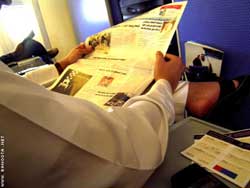 Editors and leaders from 60 countries gathered in Athens for an urgent meeting. The goal was to explore how to leverage Internet resources and develop strategies to engage readers once again.
Editors and leaders from 60 countries gathered in Athens for an urgent meeting. The goal was to explore how to leverage Internet resources and develop strategies to engage readers once again.
Print newspapers are facing a global crisis due to fierce competition from television and online news. “This is a very challenging time,” said Mike Smith, executive director of the Media Management Center at Northwestern University, during the World Association of Newspapers (WAN) seminar.
“We always see Google as a gigantic King Kong, weighing hundreds of tons, ready to crush anyone,” Smith remarked, referring to the search engine’s remarkable success in providing links to current news. “However, it also represents a significant opportunity for print media to change and succeed.”
To illustrate his point, Smith emphasized that many newspapers in North and South America have embraced the Internet wisely, using it as a powerful tool to attract more readers. Las Ultimas Noticias, a newspaper in Santiago, Chile, chose to post each page of its print edition online for readers to click and view. Meanwhile, the San Jose Mercury News has recruited young journalists to write articles on trendy topics like hip-hop in a blog style.
 |
|
Weblogs have led to the emergence of a generation of “citizen journalists” worldwide. |
Jim Chisholm, a strategic advisor for WAN, emphasized the importance of tapping into human resources. With the rise of blogs as a new media genre, millions of “citizen journalists“—a term referring to bloggers—have emerged. This group is willing to contribute articles to newspapers as well as self-publish their stories on blogs. “Instead of having a team of 50 editors and reporters, you could have around… 50,000 contributors. Why not take advantage of that?“
The growing appeal of online news sites means that print newspapers are struggling even more to attract advertising. Additionally, a new competitor is on the horizon: cable television. The advantage of cable TV is that they can inform advertisers overnight about how many viewers tuned in, and advertisers always prefer “cash on the barrel.”
In some parts of the world, such as Africa and much of Europe, print newspapers have not faced as dire a situation. However, many have begun to change due to pressure from television. “Young people today don’t care to read their parents’ newspapers,” said Eric Le Boucher, editor-in-chief of the French daily Le Monde. This month, Le Monde launched a new edition with more colors and larger fonts. “We need to attract readers as young as possible. If someone doesn’t read a newspaper by the age of 20, they’ll never touch it again in their life.”
Other speakers suggested redesigning the newspaper format to be more user-friendly for bus and subway passengers, as well as shrinking the size to fit easily in teenagers’ backpacks. Following this approach, the British newspaper Guardian recently changed its format with the slogan “So you can greet it without… straining your hands.”
However, many still affirm that print newspapers have hope for the future, as no modern technology can replicate their convenience and ease of use. “Easy to read, easy to carry, affordable, and recyclable—these are undeniable advantages of print newspapers.”
Therefore, WAN’s conclusion remains: “Dare to use the Internet; do not fear being swallowed by it.”
Cam Thi





















































